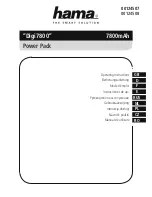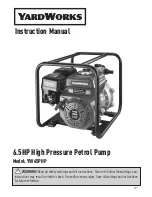
3 — English
GENERAL SAFETY RULES
SPECIFIC SAFETY RULES
Know your inflator.
Read operator’s manual carefully.
Learn its applications and limitations, as well as the spe-
cific potential hazards related to this tool. Following this
rule will reduce the risk of electric shock, fire, or serious
injury.
Risk of bursting.
Do not operate inflator to result in output
pressure greater than marked maximum pressure of item
to be inflated. Do not use at pressure greater than 150
PSI.
To reduce the risk of electric shock,
do not expose to
rain. Store indoors.
Inspect unit for cracks, pin holes, or other imperfec-
tions that could cause inflator to become unsafe.
Never cut or drill holes in the inflator.
Make sure the hose is free of obstructions or snags.
Entangled or snarled hoses can cause loss of balance or
footing and may become damaged.
Use the inflator only for its intended use. Do not alter
or modify the unit from the original design or function.
Always be aware that misuse and improper handling
of this inflator can cause injury to yourself and others.
Never leave an inflator unattended with the air hose
attached to the item being inflated.
Do not continue to use a inflator or hose that leaks
air or does not function properly.
Always disconnect the air supply and power supply
before making adjustments, servicing an inflator, or
when an inflator is not in use.
Do not attempt to pull or carry the inflator by the
hoses.
Always follow all safety rules recommended by the
manufacturer of your inflator, in addition to all safety
rules for the inflator.
Following this rule will reduce the
risk of serious personal injury.
Household use only.
Do not use inflator as a breathing device.
Never direct a jet of compressed air toward people or
animals. Take care not to blow dust and dirt towards
yourself or others.
Following this rule will reduce the risk
of serious injury.
Protect your lungs.
Wear a face or dust mask if the
operation is dusty. Following this rule will reduce the risk
of serious personal injury.
Do not use this inflator to spray chemicals.
Your lungs
can be damaged by inhaling toxic fumes.
Check damaged parts. Before further use of the infla-
tor or air tool, a guard or other part that is damaged
should be carefully checked to determine that it will
operate properly and perform its intended function.
Check for alignment of moving parts, binding of mov-
ing parts, breakage of parts, mounting, and any other
conditions that may affect its operation. A guard or
other part that is damaged should be properly repaired
or replaced by an authorized service center.
Following
this rule will reduce the risk of shock, fire, or serious injury.
Inspect tool cords periodically and, if damaged, have
repaired at your nearest Authorized Service Center.
Constantly stay aware of cord location.
Following this
rule will reduce the risk of electric shock or fire.
Risk of bursting.
Carefully monitor objects during infla-
tion.
To reduce the risk of over inflation,
use a reliable pres-
sure gauge periodically during inflation. The pressure
guage on the inflator is for reference only and is therefore
not binding for exact values.
Never leave the inflator unattended during inflation.
Allow pump to cool
for five (5) minutes after each five
(5) minutes of continuous use. Never block the inflating
or deflating outlets while operating.
Save these instructions.
Refer to them frequently and
use them to instruct others who may use this inflator.
If you loan someone this inflator, loan them these
instructions also.
Do not exceed the pressure rating of any component
in the system.
Protect material lines and air lines from damage or
puncture.
Keep hose and power cord away from sharp
objects, chemical spills, oil, solvents, and wet floors.
SERVICE
Inflator service must be performed only by qualified
repair personnel.
Service or maintenance performed by
unqualified personnel may result in a risk of injury.
When servicing an inflator, use only identical replace-
ment parts. Follow instructions in the Maintenance
section of this manual.
Use of unauthorized parts or
failure to follow Maintenance instructions may create a
risk of shock or injury.




































